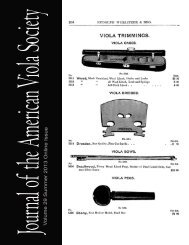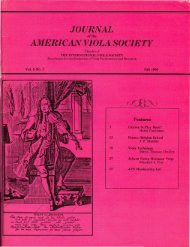Zimbalist Tango Breakdown - The American Viola Society
Zimbalist Tango Breakdown - The American Viola Society
Zimbalist Tango Breakdown - The American Viola Society
Create successful ePaper yourself
Turn your PDF publications into a flip-book with our unique Google optimized e-Paper software.
DEFINITION OF TERMS:<br />
WB – whole bow<br />
HB – half bow<br />
LH – lower half of bow<br />
UH – upper half of bow<br />
*rtk* – retake<br />
Medium/resonant lane or “md lane” – one in which you can most comfortable produce the most naturally warm, ringing sound with ease<br />
Away – near the fingerboard<br />
Tug – pull of the bow “in,” toward the bridge<br />
Imaginary string – an imaginary line which runs up and down the fingerboard between the two sounding strings when playing double-stops<br />
--------------<br />
A CAUTIONARY NOTE:<br />
What you will find here is what I call my personal “skeleton” of Zimbalit’s <strong>Tango</strong>. That is to say, what I have written down in this document<br />
is a record of all of the technical directives which I have spent hours in the practice room slowly ingraining into both my mind and body<br />
(muscle memory) – until every motion and thought has become habitual. However, since performing a piece EXACTLY the same way every<br />
time one plays it is never the goal for any musician, this state of ‘habit’ is meant ONLY to be a stable foundation upon which one can fall<br />
back upon during any performance for physical comfort and ease along with technical confidence and consistency. Please note that it is<br />
the conscious, purposeful, and delightful(!) deviations FROM this foundation which can make a performance come alive and breathe. <strong>The</strong><br />
purpose of developing a safety net of a solid “game plan” is merely to help lend the confidence needed to take those risky deviations in<br />
performance and ultimately to enjoy creating a version of the piece which is unique to each performer.<br />
I gladly offer whatever of these technical directives that any reader would like to take in and make his or her own, but I also challenge<br />
readers to take the time in the practice room to create their own personal, unique skeletons – as each violist is built differently on so many<br />
different levels (physically, mentally, musically…).<br />
ONE FINAL GENERAL THOUGHT: Overall, the three BIG technical ideas that help the most in playing this piece are…<br />
1) Thinking, hearing, and visualizing intonation AHEAD of the right hand. That’s right. You know EXACTLY where those notes lie<br />
on the fingerboard, so give your brain a head start and NAIL them every time!<br />
2) Staying balanced in the right arm and keeping bow arm motions simple - moving back and forth along each string’s horizontal<br />
plane (or imaginary string’s horizontal plane if it’s a double stop), and therefore eliminating extraneous motions which can<br />
lead to tension and therefore inaccuracy.<br />
3) Bow division (or ‘bow planning’) within these horizontal planes in order to remain relaxed and released – and therefore<br />
comfortable whilst creating a vibrantly resonant and expressive sound. When the brain has a plan, it gives up the need to<br />
panic during any ‘hard spots.’










